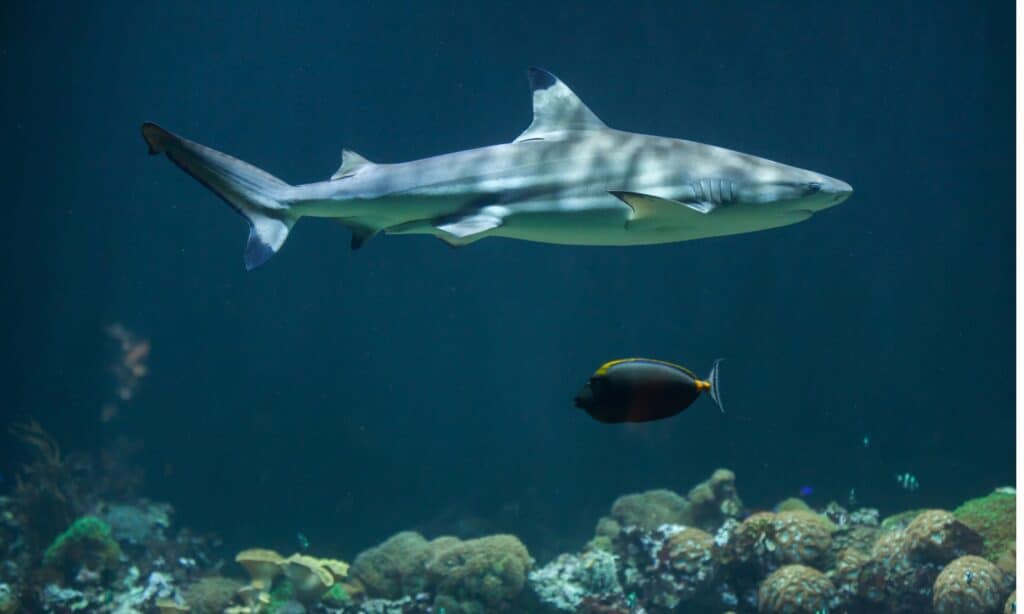On average there are 19 annual shark attacks in the US. The fatality rate of these attacks is very low. Only one person dies from a shark attack every two years on average. Sharks have well-developed senses that make them remarkable predators. They can detect potential prey miles away through sight, sound and smell. Despite how ferocious these fish are, encounters with humans are rare. For instance, the number of shark attacks that happened in Hawaii throughout 2022 was just seven for the whole year. This post explains some of the 2022 shark attacks in Hawaii and how they happened.
Hawaii Shark Attacks in 2022
The yearly number of shark bite victims in Hawaii is an average of 3 to 4 people. Death as a result of the bites is even rarer in comparison to the large number of people that visit the islands all year round. Some of the shark attacks recorded in 2022 are:
February 9, 2022
This is the first recorded shark attack in Hawaii in 2022. It happened around 3:00 am on February 9. The incident occurred about 1.5 miles away from Kailua Beach Park’s shore in Kailua-Kona. The victim was found floating in the water. Although it is not certain if the incident was provoked or not, the victim sustained injuries on his right foot and calf. The attacking shark was identified to be a cookiecutter shark (also known as the cigar shark).

The first recorded shark attack in Hawaii in 2022 was by a cookiecutter shark.
©PIRO/NOAA Observer Program, Public domain, via Wikimedia Commons – License
March 3, 2022
An unidentified individual was scuba diving in Kailua-Kona, about a mile from the shore, when a six-foot-long Galapagos shark attacked. The incident happened at about 2:00 pm on March 3. Fortunately, the victim survived the encounter with just a puncture wound on the big toe of the right leg. The attack was recorded as a provoked incident.

On March 3, 2022 there was a provoked attack by a Galapagos shark leaving a scuba diver with a puncture wound.
©wildestanimal/Shutterstock.com
September 3, 2022
Around 4:00 pm on this tragic day, a 51-year-old tourist from France fell victim to a shark attack in Hawaii. The size and species of the predator fish that attacked her remain unknown. The unlucky victim was snorkeling in the turbid waters at a depth of 10 to 15 feet. The woman was about 20 yards away from Paia Bay in Maui when the shark bit her arm. She suffered puncture wounds on her left torso. She also lost some of her right-hand fingers and left arm to the shark.
September 9, 2022
Six days after the incident above, a provoked incident happened at Keahole Point, Kailua-Kona, in Hawaii. The victim decided to go scuba diving in the clear Hawaiian waters but was attacked by a long blacktip shark. The shark bit into the diver’s left leg, leaving several lacerations and puncture wounds on the calf and ankle.

A blacktip shark attacked a scuba diver in Kailua-Kona, Hawaii causing minor injuries.
©iStock.com/wrangel
October 18, 2022
The victim of this attack, identified as A. King, was surfing some yards away from the Razorbacks’ shore in Kaaawa, Oahu, around 11:00 am. At some point, a 6 to 8-foot-long shark attacked him, and the victim’s right big toe ended up with some lacerations.
October 25, 2022
An unidentified shark attacked a snorkeler 15 to 20 yards away from the shore of Kalapaki Beach, Kauai. The waters were unclear around 4:00 pm when she got attacked. The victim was lucky enough to survive the encounter unharmed. The shark was only able to bite off her swim fin.
December 8, 2022
This was the fatal shark attack of the year. A married couple, Blake and Kristine Allen, were snorkeling around the Keawakapu Point, Kihei, in Maui. The 60-year-old couple noticed a shark swimming continuously around them. Around noon, Blake lost track of his wife about 50 yards away from the shore. He frantically swam back to alert the appropriate authorities. The turbid waters, in addition to other unfortunate circumstances, made it challenging to identify the shark species. The chances that Kristine Allen survived the ordeal are very low, and her body is still yet to be recovered.
An anonymous eyewitness claimed that a 12-foot tiger shark attacked the woman. Some other people involved in the search also reported they had seen a shark swimming around. After an extensive search, only a bathing suit and mask were found.
Although not officially confirmed, another tiger shark bit a 68-year-old man 400 yards off the shores of Anaehomalu Bay on the Big Island. Despite the injuries he got on his lower left torso, he managed to fight off the shark with his knife. Paddleboarders helped him get to shore and rushed him to a local hospital. He was later moved to Oahu for further treatment. Tiger sharks were spotted on the beach, which led to its temporary closure.
What Is the Major Shark Species Responsible for the Attacks in Hawaii?
The species of the offending predator fish in attacks are not often identified in most cases. However, tiger sharks seem to be the most significant assailant in shark attacks.
This shark species is the most dangerous in Hawaiian waters. Their diet is rather broad in comparison with other species. Tiger sharks prey on living birds, turtles, and lobsters. They also eat dead animals and even garbage.
The exact reason they bite humans is not known. Some believe that they perceive humans as their natural prey due to poor visibility. Although there are records of shark attacks occurring in clear and turbid water conditions at night and daytime. Alternatively, they may just be trying to explore more feeding options. Considering the wide range of tiger sharks’ food, these assumptions may be correct to a certain extent.

Tiger sharks seem to be the most significant assailant in shark attacks in Hawaii.
©iStock.com/Sean Craft
Incidents Classification
The International Shark Attack File (ISAF), a worldwide database of shark attacks, groups incidents of shark attacks into two: provoked and unprovoked. Provoked incidents occur when the human first tries to have physical contact with the predator. The attempt may be intentional or accidental.
For instance, a bite that happens when a fisherman tries to remove a shark from a fishing net is provoked. A surfer who suddenly falls from their board beside a shark is also classified as provoked, although it seems accidental. On the contrary, it is an unprovoked incident when the human attempts no initial physical touch. Examples include attacks on boats or an already drowning human.
Conclusion
About 40 identified species of sharks roam the Hawaiian waters. Whitetip reef, sandbar, and hammerhead are the typical shark species you are most likely to find nearshore. There are also occasional sightings of the tiger shark. Few people see sharks, and much fewer experience shark bites on the islands. Although shark bites casualties are extremely low, people need to be aware of the lurking dangers associated with the marine environment. You should always take safety precautions before participating in any water activity.
Up Next
- Where are the Most Shark Attacks in the World?
- The Deadliest Shark Attack in Human History
- 5 Florida Beaches with the Most Shark Attacks
The photo featured at the top of this post is © iStock.com/Divepic
Sources
- State of Hawaii, Available here: https://dlnr.hawaii.gov/sharks/shark-safety/fact-sheet
- State of Hawaii, Available here: https://dlnr.hawaii.gov/sharks/shark-incidents/incidents-list
- Tracking Sharks, Available here: https://www.trackingsharks.com/man-fights-off-shark-attack-with-diving-knife
Thank you for reading! Have some feedback for us? Contact the AZ Animals editorial team.






